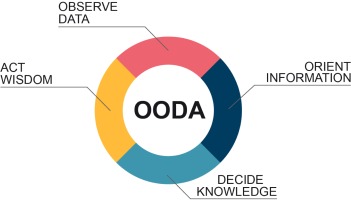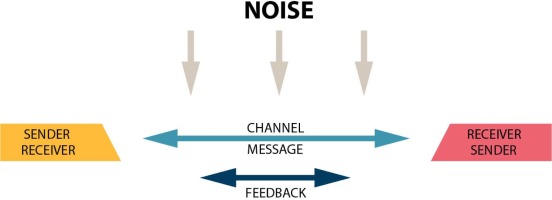Introduction
Over the last tens of years, the way conflicts in international relations are handled has changed. The dynamic development of numerous fields of knowledge and technologies based on microelectronics and advanced algorithms of data processing are the main factors in this case. The above-mentioned changes have determined that a human-being currently lives in an information-based society, in which information is the most valuable intangible item. These changes caused the evolution of safety conditions and, at the same time, they strongly affect targets and the way contemporary wars are conducted (Jezierski et al. 2018).
In terms of supporting military operations, the dynamic development of information, communications and the new interdisciplinary technologies sector results in the need for constant development of the process of creating information superiority. The ICT Sector currently dominates numerous areas in which humans operate (Rybak et al. 2018) and what is more, it constantly replaces or augments certain real processes which are carried-out by human beings with virtual reality equivalents (Kęsy 2016, p. 125).
Over the last couple of years, virtual reality systems have become highly prevalent. They devolve an excerpt of the real world to the computer-generated experience within a simulated environment. In terms of the contemporary battlefield, virtual reality systems not only support the soldiers in action, but they can also successfully support the process of training soldiers in various and repeatable conditions. It results from the fact that computers, which are accessible on the market, have a computing power that allows the virtual world to be authentically visualised (Kęsy, 2016, p. 126).
Information superiority should be perceived as a dominance over the opponent in the information-based sphere, which results from the ability to gather, process and last but not least, use it effectively (Dudczyk and Matuszewski 2005, p. 30). We can distinguish several integral components of creating information superiority. These include the defence of information and preclusion of every kind of opponent’s activities, which could be potentially threatening to the organised informational potential. Furthermore, the assurance of situational awareness, which allows the battlefield to be authentically visualised via access to updated information, is an inseparable factor of increasing information superiority. Because of the abovementioned actions, the adjustment of entities to dynamic battlefield conditions is possible while the operational tasks are being conducted (Dudczyk and Matuszewski 2005, p. 30). In order to complete these tasks (Dudczyk and Matuszewski 2005, p. 30), the following resources are used most frequently:
Unmanned Aerial Vehicles (UAV) (Bielawski et al. 2018, p. 6);
Airborne Warning and Control System; Joint Surveillance and Target Attack Radar System;
radio receivers and radars, Synthetic Aperture Radar;
conventional weapons;
electromagnetic weapons;
implementing a malicious subroutine in an opponent’s ICT Systems;
modern ICT Systems, which analyse data flow;
intelligence (Dudczyk and Matuszewski, 2005, p. 30).
Taking into account the above-mentioned dynamic development of the ICT, including virtual reality simulators, which are more and more often used in supporting military operations, and looking through available methods of creating information superiority – the question we ought to ask is whether virtual reality systems could become one of those methods on the contemporary battlefield?
This paper focuses on data processing and information transmission, distinguishing virtual reality environments as a tool for creating information superiority on the contemporary battlefield.
In the next chapters the application of virtual environments in military simulations will be covered. Firstly, the process of data processing in IT Systems, which correlates with the Observe Decide Act Cycle, will be discussed. Subsequently, due to the virtual environment structure and defined purpose of this article, presenting individual components of the communication process is necessary. Last but not least, the potential of applying virtual reality systems in the process of creating information superiority and improved soldier training environments will be elaborated on.
Virtual reality systems in military simulations
The increase of information superiority over an opponent results from effective use of processed data. Thus, the simulation of challenging and highly-possible battlefield conditions, where soldiers are forced to make high risk instant decisions, is the key factor in creating information superiority via virtual reality systems.
The purpose of applying such systems is to satisfy informational necessity, which results from the fact that individual levels of management require access to the current as well as future battlefield conditions. It is necessary in order to effectively make crucial decisions, which are essential in resource management. Furthermore, the command centres have to constantly arrange and evaluate potential movements of the forces. Due to the dynamic development of the ICT Sector, virtual reality systems have become more accessible. The equipment is cheaper and its computing power has significantly increased. Owing to this, during the conflict, the specialist teams are simultaneously capable of creating virtual models of the battlefield. Filling in such an environment with data gained via an unmanned aerial vehicle equipped with integrated sensors, (Sawicki 2012, pp. 365-366), allows various scenarios to be simulated and the most advantageous one to be chosen (Haar 2005, p. 3).
According to the aforementioned facts, scientists have been carrying-out analyses regarding solutions used in the military sector which deployed virtual reality technology over the last few years (Haar 2005, pp. 1-7, Lele 2013, pp. 17-26, Kęsy 2016, pp. 125-131, Siu et al. 2016, pp. 214-220).
René ter Haar and Jonathan Strickland elaborate on the system called Dragon Battlefield, which allows the battlefield to be visualised in the form of a virtual workbench, on which the map of the terrain is spatially displayed. Visualised in such a way, the information pertains to, for instance, any units which are located in the particular area. Thanks to the interdisciplinary techniques, which were mentioned in the Introduction, the Dragon Battlefield System can visualise information about the current situation on the battlefield, such as the number of units, their location, the direction they are heading in, or even the velocity of their movements (Haar 2005 pp. 3-4). It is worth mentioning that Dragon Battlefield users are able to explore the three-dimensional battlefield model at any camera angle. This allows conclusions to be drawn regarding the strategy and solutions to any potential obstacles, which could not have been spotte, while using the traditional methods for data visualising. Furthermore, in comparison to commonly used visual communication systems, virtual environments allow users to be more engaged in the process of simulation and, thanks to immersion, they are able to acquire completely new information (Strickland 2011). Immersion is defined as the mental presence and the involvement in the virtual world (Örtqvist and Liljedahl 2010, p. 2). Extending this definition, immersion is the major idea of the virtual reality system and it directly affects the usefulness of the individual virtual environment (Lele 2011, p. 21). The abovementioned development of technology allows for optimisation, up to perfection, of the process of analysing the digitalised information which was acquired from the prospective simulations of the battlefield (Haar 2005, p. 3). Virtual Training Technology, which is used by the U.S. army, is another instance of application of virtual reality systems. In the laboratories of the U.S. Navy, training courses for the sailors are conducted with a view to learning how to handle a fire on navy ships. According to Jonathan Strickland, the Virtual Training Technology was being verified in 2011, and its purpose was to create opportunities to train in extremely hazardous but at the same time controlled and not life-threatening conditions for the soldiers (Strickland 2011). Ajey Lele puts strong emphasis in his article on the potential that virtual reality systems have in Air Force simulations. Lele shows that the most crucial benefit of the simulation in a virtual environment is the possibility to make complex and risky decisions or movements, which would be extremely difficult to make in the real world, even with the assistance of expensive and professional equipment. Whereas virtual reality systems are able to simulate the failure of equipment or detrimental weather conditions with no risk of damaging the hardware or, even more relevant, people (Lele 2011, p. 20).
Information hierarchy as a foundation in the process of increasing information superiority
From the technical point of view, the process of creating information superiority and situational awareness requires suitable ontology and taxonomies, which are vernacular not synonymous. It should be emphasised that terms such as “data” or “information” should not be used as synonyms (Rybak et al. 2018). In terms of creating information superiority with the use of virtual reality systems, the final outcome of the operation, which was simulated in a virtual environment, is the most crucial information for the entity. Based on the simulated battlefield conditions and acquired information, a human being is able to make decisions and simultaneously draw conclusions regarding the possible results (Dudczyk and Matuszewski 2005, p. 23).
Defining virtual reality systems as a tool for creating information superiority on the contemporary battlefield requires presenting information hierarchy and the process of its processing. According to the definition, which was mentioned in the Introduction, in order to effectively create information superiority, an entity has to obtain information about the situation of the opponent from the collected data and, on the basis of it, forecast the potential conditions of the battlefield, anticipate the opponent’s actions and finally control the situation on the battlefield (Dudczyk and Matuszewski, 2005, p. 30). The dynamic development of the ICT Sector has determined that scientists have started to carefully spectate on the issues of data processing (Dudczyk and Matuszewski, 2005, p. 23). As the literature says, the term “information” can be equivalent to terms such as message, hint or alert (Dudczyk, Matuszewski, 2005, pp. 23-24). The evolution of the ICT Sector, however, gives a completely new meaning to the word “information”. It is assumed that the same data combination on the opposite side of the processing process can lead to different information. In terms of creating information superiority, it is said that information is the key factor, which allows the degree of lack of knowledge about a particular phenomenon to be reduced and the surroundings to be identified, which eventually simplifies the process of decision making and executing strictly defined operations. In order to understand the process of transmitting raw data into information and then knowledge, it is necessary to define information hierarchy with the use of ICT Systems (Dudczyk and Matuszewski, 2005, pp. 23-26).
The data is the lowest level in the data processing. It is defined as certain statistically described features of an individual object, event, measurement or observation. It is usually presented in the form of figures. Complex volumes of “raw data” are not composed information for the receiver. As a result, this is not enough to create the communication process. During the information processing, organising, visualising, analysing and interpreting, the information obtains a meaning, different for each of these stages of processing. Interpreted information is the product of the above-mentioned operations. In comparison to “raw data”, information is recorded more formally, as it is usually formulated in the form of elementary conclusions. In terms of the communication process, the contextual character of interpreted information is an invaluable benefit. Information exchange is easier and clearer in comparison to raw data, because a reference to known interpretation context may be made. Knowledge development is the next step in the processing, which is created via the correlation between information and experience as well as situational awareness and the understanding of particular facts. Knowledge is here defined as the aggregation of the receiver learning, conclusions, observation and analysis. In terms of the processes mentioned previously – communication and creating information superiority – expanding the knowledge is the main goal. The last level in the information hierarchy is wisdom, which is defined as a state, which in correlation with knowledge, allows the receiver to discover patterns that are hidden in a dataset. It is worth mentioning that in comparison to knowledge, a measurable method which would allow wisdom to be learned or conveyed has never existed (Rybak et al. 2018).
In terms of the military sector and creating information superiority within it, the process of information processing ought to be connected to the Observe Orient Decide Act model. According to its definition, it is a cyclical operation. Thus, rational human or organisational behaviour can be illustrated as an unlimited looping of four tasks, which come one after the other: observe, orient, decide and act (Dudczyk and Matuszewski 2005, pp. 24-25). Observe is a process of gathering data, which is a raw characterisation of the area in which operations are being executed. Then comes the orient, which is based on acquired information, and an individual conceptual model is created. A strictly defined choice of scenario is made later. It ought to be emphasised that this particular act can either be analytical or reasoning-based. Last but not least, the part where the particular decisions are most often made according to the previously established algorithm is carried-out. The most crucial benefit of the OODA model is its ability to adapt. It is worth mentioning that after the last cycle of the loop, acquired information is conveyed in consecutive iteration to the observation part. The correlated hierarchy between information and the OODA cycle is illustrated below (Figure 1.).
Figure 1
Information hierarchy correlated with OODA cycle
Source: Own elaboration based on (Rybak et al. 2018).

Commonly used data-analysing ICT systems are highly complex. The best examples are the processing systems of the big data warehouses, which have to process unstructured big data volumes, for example Apache Hadoop. The key benefit of using them is to greatly reduce the data processing period, which results from the tremendous computing power of the hardware (Abderrazak et al. 2017, pp. 1-2). It ought to be emphasised that “raw data”, which is located at the entry to the system, is mostly unknown to the user. This characteristic of contemporary ICT systems has caused the acceleration of strategic operations. The duration of the decision on military operations has been reduced to several hundred minutes (Dudczyk and Matuszewski, 2005, p. 25). Simultaneously, the dynamic development of the ICT Sector means that contemporary conflicts have been transferred to the cybernetic battlefield (Jezierski et al. 2018).
Interactive virtual environment as a channel in the communication process
In terms of virtual reality environments, the communication process theory is another topic, which needs to be mentioned. The main idea is the accurate or approximate re-enactment of information, which was previously broadcast in a different location. Broadcast messages usually already have their own meaning. In terms of creating information superiority, it means that they were correlated with the experience, situational awareness, understanding of the facts and individual conceptual model (Shannon 1948, p. 1). As a result, information hierarchy and communication process are the key components of virtual reality systems, which strictly correlate with Information Theory, which was initiated by C.E. Shannon in 1945 in his article regarding the mathematical theory of cryptography (Shannon 1945, pp. 1-111), which was supplemented in 1948 with A Mathematical Theory of Communication (Shannon 1948, pp. 1-55). Shannon classified communication systems into three main categories:
Discreet – where the message and the signal are a discreet sequence. A common instance of this type is telegraphy, where the information is a sequence of letters, which are expressed as dots, dashes and certain intervals between them;
Continuous – where both the message and the signal are defined as a continuous function, e.g. radio or TV;
Mixed – where messages can be both discreet and continuous. Pulse-Code Modulation systems are an example of mixed type of communication systems (Shannon 1948, pp. 2-3).
With the development of the ICT Sector, the number of systems has significantly increased. According to the classification suggested by Shannon, virtual reality environments can be classified as systems where the communication is continuous and information is most frequently conveyed via image and sound. The examples mentioned in Virtual reality systems in military simulations, such as VR googles, headsets, gloves and suits, which simulate current battlefield conditions, are a justification of this fact (Haar 2005, p. 1).
The effectiveness of virtual reality systems strongly depends on the methods of the human being’s interaction with a simulated virtual environment (Haar 2008). Thus, the coherence of applied methods and controllers in the human-computer interaction is the most crucial aspect of virtual reality systems, which allow battlefield circumstances to be simulated and to eventually support the strategic process of decision making. A popular example in which the communication process can be indicated is the data visualisation developed by John Snow in 1854. He created a map of the cholera epidemic in London. Using this, he was able to state that the cause of the outbreak was a water pump in one of the districts. It should be emphasised that without using this method, it was thought that the disease was transmitted in the air, which was a mistaken conclusion. Therefore, communication processes in virtual reality systems that are not optimally carried-out can lead to erroneous conclusions, which can finally determine the ineffective use of gathered information, which would make the creating of information superiority impossible (Rybak et al. 2018, pp. 7-8).
Figure 2 shows the communication process scheme that was developed by C.E. Shannon (Shannon 1948, p. 2). Nowadays, communication process theory affects the interaction designing, as its purpose considers the human factor which is used in the process of creating information superiority on the contemporary battlefield (Rubio-Tamayo et al. 2017, p. 24). As a result, an immersion-type virtual reality system ought to be designed according to the concept shown below (Figure 2.).
The sender and receiver are both engaged in the interchange during the communication process, the purpose of which is to recreate the message, which was previously sent by the sender, in the receiver section. It is a highly complex issue, as both interchanges have different data processing potentials. In terms of virtual reality systems, the sender is a part of the system. Whereas the receiver is the user that receives incoming messages via senses such as sight and hearing. Another component of the communication process is the communication channel, which is a transmitter between the sender and receiver. In terms of technology, these would be VR googles and headsets. The communication channel is especially affected by the noise (Shannon 1948, pp. 2-3). According to information transmission in virtual reality systems, noise can be classified into two categories:
inner – which results from the current, overall user’s condition while the system is explored. The fatigue is an instance of inner noise;
outer – which can be defined as any disruptions which are found in the surroundings such as the temperature of environment.
Feedback, which is the user’s reaction to the current environment, is the last component of the communication process in terms of applying virtual reality systems to create information superiority. It is the most crucial factor if simulations are expected to lead the entire process for defining strategic conclusions, which are necessary to wage a conflict in dynamic conditions (Shannon 1948, p, 2-3).
Conclusion
The dynamic development of the ICT technologies and their effective use on the real battlefield is a highly relevant factor in terms of the functioning of contemporary and future armies.
Based on the carried-out analysis, the following crucial benefits of using virtual reality systems in terms of creating information superiority can be pointed out:
reduced risk to health and life;
possibility of efficient and relatively inexpensive examination of various strategic outcomes;
acceleration of the strategic decision making process.
In terms of the communication process, virtual reality systems are transmitters between the user and the model which describe the current battlefield conditions. The user can react to various signals that can come in the form of an image or sound, which as a result of feedback will affect the virtual environment. Thus, a virtual reality system allows certain operations to be simulated, which in correlation with data that describes current conditions on the battlefield, allow strategic decisions regarding further operations to be taken.
Virtual reality systems are a highly innovative tool in the process of creating information superiority. Nevertheless, in order to use them effectively, the assistance of other special equipment, such as UAV, which delivers information to the entry of the virtual reality systems, is necessary. When the information is delivered, the virtual reality system is able to simulate further operations and their possible outcomes on the battlefield.





